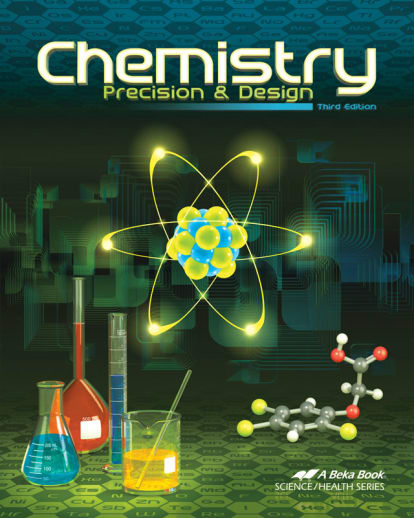The student textbook provides textual readings, feature articles, mathematical equations, and the section and chapter reviews. Space to record answers is not included, so students will need a separate notebook. Text is well illustrated with graphics and colorful photographs throughout the text aid student understanding. The appendices provide resource tools including SI prefixes, metric and US units, fundamental constants of nature, the periodic table, and an index of atomic symbols.
Abeka Chemistry: Precision and Design Student Textbook
Description
Present molecular and descriptive chemistry from a Creation-based, Christian perspective with Chemistry: Precision and Design. Start off with subatomic particles and the periodic table and graduate into balancing chemical equations and understanding chemical bonds. Learn about metals and nonmetals, solutions and colloids, and chemical thermodynamics and kinetics. With almost 400 figures and charts, Section and Chapter Reviews, and 32 articles that relate chemistry to everyday-life, your child will develop an understanding and appreciation for chemistry.
Presenting the fundamental principles of chemistry, this course teaches current scientific understanding through the lens of God's creation and gives students an appreciation of how chemistry benefits mankind. With its comprehensive coverage of topics including biochemistry, this course will prepare students for college level Chemistry courses. Algebra 1 is a prerequisite.
The Student Textbook provides textual readings, feature articles, mathematical equations, and the section and chapter reviews. Space to record answers is not included, so students will need a separate notebook. Text is well illustrated with graphics and colorful photographs throughout the text aid student understanding. The appendices provide resource tools including SI prefixes, metric and US units, fundamental constants of nature, the periodic table, and an index of atomic symbols.
The Teacher Guide provides the full student text at the beginning and the teaching resources in the back. Teacher resources include the scope and sequence with a suggested teaching schedule, grading scale, daily lessons, and answers to the text questions. Also included are science project instructions and chemistry lab safety information. If you prefer to not use the teacher guide, a separate answer key is available that includes the answers only to section and chapter reviews from the student text.
Additional resources include the Lab Manual, Quiz Book, and the Test Book. Answers are not included; each book has a separate teacher guide or answer key.
The Lab Manual provides 27 experiments and begins with a focus on laboratory regulations and safety. Emergency procedures are also covered, and it is recommended you review them periodically. Each experiment begins with an overview, equipment and supply lists, step-by-step instructions and a report sheet. You will need to provide numerous items including a lab coat/apron, safety glasses/goggles, beakers, flasks, graduated cylinders, test tubes, Celsius thermometer, and numerous specialty chemicals. Please contact Rainbow Resource for a full listing. Alternatively, homeschool families may be able to incorporate a high school level chemistry kit like, MicroChem Kit item #020028. While not intentionally aligned with the 4th edition Abeka Chemistry, with a little effort, parents can line up the experiments with the more classroom focused Abeka lab activities.
The Lab Manual Teacher Guide includes the complete student lab manual with answers and teacher notes for each experiment. A comprehensive listing of necessary supplies/equipment is included.
The Test Book provides a total of 12 exams: 8 tests (one every 3 weeks), 2 nine-week exams, a semester exam, and a final exam. Questions vary from short answer or multiple choice to essay questions to test understanding and application of material. The Quiz Book includes 27 quizzes which offer a variety of reinforcement exercises including matching, true or false, short answer questions and mathematical equations. Answers for the test book and quiz book are found in the corresponding answer keys (Quiz Key & Test Key). Student and teacher resources are not reproducible.
Also available are the Chemistry Student and Parent Kits. The Student Kit includes the textbook, test book, quiz book, and lab manual. The Parent Kit includes the teacher edition, the test key, quiz key, and the Lab Manual Teacher Edition.
| Product Format: | Paperback |
|---|---|
| Grade: | 11 |
| Brand: | Abeka |
| Length in Inches: | 10 |
| Width in Inches: | 8 |
| Height in Inches: | 0.5625 |
| Weight in Pounds: | 1.5 |

